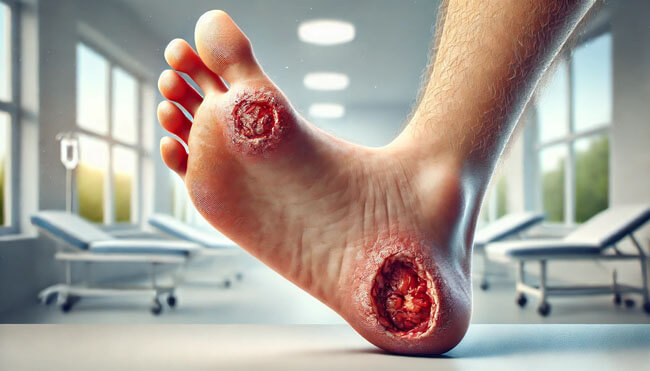Diabetic foot ulcers are a serious complication that can develop in individuals with diabetes, often leading to severe outcomes if not properly managed. This guide aims to provide a detailed overview of diabetic foot ulcers, including their causes, symptoms, complications, and preventive measures, with a special focus on homeopathic remedies for management.
Understanding Diabetic Foot Ulcer
A diabetic foot ulcer is an open sore or wound that occurs most frequently on the bottom of the foot in individuals with diabetes. This condition is a result of multiple factors associated with diabetes, including nerve damage (peripheral neuropathy), poor blood circulation, and a decreased ability to heal. Peripheral neuropathy reduces sensation in the feet, making it difficult for individuals to feel injuries, blisters, or cuts. As a result, even minor wounds can go unnoticed and become ulcers.
Furthermore, diabetes impairs blood flow, especially to the lower extremities, which slows down the healing process and increases the risk of infection. Dry skin, a common problem in diabetics, can lead to the formation of calluses. These calluses, when not managed properly, can break down, creating open sores that are susceptible to ulcers.
Diabetic foot ulcers are a significant concern because they can lead to infections, gangrene, and even amputation if not treated promptly and effectively. The following sections explore the signs, symptoms, complications, and risk factors associated with diabetic foot ulcers, as well as preventive measures and homeopathic management.
Signs and Symptoms of Diabetic Foot Ulcer
Recognizing the early signs of a diabetic foot ulcer is crucial for timely intervention. Some common symptoms include:
- Drainage from the Affected Area: Fluid or pus may drain from the ulcer, which can stain socks or shoes.
- Redness and Swelling: The skin around the ulcer may appear red and swollen, indicating inflammation.
- Pain or Numbness: Although neuropathy can reduce sensation, some individuals may still experience pain or discomfort in the ulcerated area.
- Foul Odor: An unpleasant smell may emanate from the ulcer, especially if it becomes infected.
- Blackened Skin: A blackened area around the ulcer suggests tissue death (gangrene), often due to poor blood supply.
- Increased Warmth: The affected area may feel warmer than the surrounding skin.
- Visible Cracks or Calluses: Thickened, cracked skin, or calluses may be present around the ulcer.
Complications of Diabetic Foot Ulcer
If left untreated, diabetic foot ulcers can lead to severe complications:
- Infection: Infected ulcers can spread to deeper tissues, leading to cellulitis (a bacterial skin infection) or osteomyelitis (a bone infection).
- Gangrene: When blood flow to the area is severely compromised, tissue death can occur, resulting in gangrene. This may necessitate amputation.
- Amputation: In severe cases, amputation of the affected limb may be required to prevent the spread of infection or gangrene.
Risk Factors for Diabetic Foot Ulcers
Several factors increase the risk of developing diabetic foot ulcers:
- Poor Glycemic Control: High blood sugar levels can damage blood vessels and nerves, making ulcers more likely.
- Foot Deformities: Conditions such as hammertoes, bunions, or Charcot foot can cause abnormal pressure points, leading to ulcers.
- Inadequate Foot Care: Neglecting foot hygiene, not trimming toenails properly, or wearing ill-fitting shoes can contribute to ulcer formation.
- Tobacco Use: Smoking impairs blood circulation, increasing the risk of ulcers and delaying healing.
- Obesity: Excess weight puts additional pressure on the feet, raising the risk of ulcers.
Preventive Measures for Diabetic Foot Ulcers
Preventing diabetic foot ulcers is essential for maintaining foot health and avoiding severe complications. Key preventive measures include:
- Blood Sugar Control: Keeping blood glucose levels within the target range helps prevent nerve and blood vessel damage.
- Regular Foot Inspections: Check feet daily for cuts, blisters, or other abnormalities. Use a mirror to examine the soles and between the toes.
- Proper Foot Hygiene: Wash feet daily with lukewarm water and mild soap, and dry them thoroughly, especially between the toes.
- Moisturizing: Apply a moisturizer to keep skin soft, but avoid areas between the toes where moisture can cause fungal infections.
- Trimming Toenails Carefully: Trim nails straight across and file the edges to prevent ingrown toenails.
- Wearing Proper Footwear: Choose shoes that fit well, provide adequate support, and avoid tight or narrow shoes that can cause pressure points.
- Avoiding Tobacco: Quit smoking to improve blood circulation and reduce the risk of ulcers.
- Regular Podiatry Visits: Schedule regular check-ups with a podiatrist to monitor foot health and address any issues early.
Homeopathic Management of Diabetic Foot Ulcers
Homeopathy offers a holistic approach to managing diabetic foot ulcers by focusing on individualized remedies that address both the ulcer and the underlying factors contributing to its formation. While homeopathic medicines can be effective in mild to moderate cases, they should always be used under the guidance of a qualified homeopathic physician. Severe cases of diabetic foot ulcers require conventional medical treatment, and homeopathy should not be relied upon as the sole treatment option.
Below are ten of the most suitable homeopathic remedies for diabetic foot ulcers, along with their key symptoms and conditions:
1. Arsenicum Album
- Key Symptoms: Burning pain, ulcers with offensive discharge, and restlessness.
- Conditions: Best suited for ulcers with a burning sensation, especially when the skin feels cold and the ulcer emits a foul smell. It is particularly helpful for ulcers on the soles or toes accompanied by a yellow, foul-smelling discharge.
2. Graphites
- Key Symptoms: Crusty ulcers, watery or blood-stained discharge, and slow healing.
- Conditions: Ideal for patients with a tendency for skin ulceration and slow healing. Ulcers are often crusty with a watery or bloody discharge, accompanied by severe itching and inflammation.
3. Fluoricum Acidum
- Key Symptoms: Painful ulcers near joints, relief from cold applications.
- Conditions: Useful for ulcers that form around the joints, with red margins and a burning sensation. The ulcers may be painful, with relief from cold and an increase in pain from warmth.
4. Kali Bichromicum
- Key Symptoms: Irregular ulcers following abrasions, dry scabs, and yellow, oval-shaped ulcers.
- Conditions: Suitable for ulcers with a knot-like swelling that develops after an abrasion. These ulcers are typically yellow, oval-shaped, and painful to touch, with a hard base and red center.
5. Mercurius Solubilis
- Key Symptoms: Ulcers with inflamed, elevated margins, pricking pain, and whitish-grey base.
- Conditions: Indicated for superficial ulcers with inflamed, raised edges and pricking pain. The ulcers may exude thin fluid or blood and are aggravated by warmth.
6. Lycopodium Clavatum
- Key Symptoms: Ulcers with red, hard, shiny edges, tearing pain, and foul-smelling discharge.
- Conditions: Effective for ulcers with red, hard, and shiny edges, accompanied by tearing or shooting pain, especially at night. The ulcers may itch and burn, with a thin, foul-smelling discharge.
7. Carbolicum Acidum
- Key Symptoms: Ulcers with extremely foul odor, burning pain, and heavy feet.
- Conditions: Valuable for ulcers that emit a very strong, offensive odor. There may be burning pain and heavy-feeling feet, often with foul-smelling sweat.
8. Phosphorus
- Key Symptoms: Ulcers with thin, pus-like discharge, burning, and stinging pain.
- Conditions: Indicated for ulcers with thin, pus-like discharge and surrounding redness. The ulcers may burn and sting, with a tendency to bleed.
9. Pulsatilla Nigricans
- Key Symptoms: Ulcers with burning, itching, stinging sensation, and hard edges.
- Conditions: Best for ulcers with burning and itching around the periphery, accompanied by stinging pain and hard, red edges. The ulcers are usually flat and may cause smarting or shooting pain.
10. Petroleum
- Key Symptoms: Ulcers on toes, hard edges, red base, and offensive sweating.
- Conditions: Effective for ulcers forming on the toes, with hard, elevated edges and a red base. The ulcers are moist and may be accompanied by swelling and offensive sweating.
Disclaimer:
This information is for educational purposes only and is not a substitute for professional medical advice, diagnosis, or treatment. Always consult your physician or a qualified healthcare provider regarding any medical condition. Use homeopathic remedies under the guidance of a certified practitioner.
Similar Posts

Remedy for Diabetes rheumatic pains in homeopathy

Uranium Nitricum (Uran-n): A Bird’s Eye View of the Homeopathic Diabetes Remedy

Mouth Symptoms in Diabetes:Homeopathic Medicines and Their Indications

Face Symptoms in Diabetes:Homeopathic Medicines and Their Indications

Hearing Symptoms in Diabetes:Homeopathic Medicines and Their Indications

VISION: Diabetes Symptoms and Homeopathic Medicines

Eyes-related symptoms in diabetes: Homeopathic Medicines and Their Indications

Head-related symptoms in diabetes: Homeopathic Medicines and Their Indications

Vertigo Symptoms in Diabetes: Insights for Homeopathic Treatment

Mind Symptoms in Diabetes: Rubric, and Homeopathic Remedies

Repertorial Symptoms Related to Diabetes Mellitus and Its Complications

Homeopathic Medicines and Concomitants for Managing Diabetes

Diabetes: Causes, Miasms, and Homeopathic Medicines

Diabetes and Homeopathy: Effective Remedies According to Boericke’s Materia Medica

